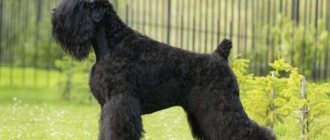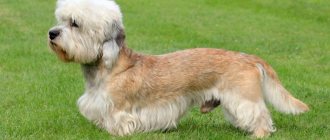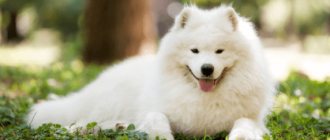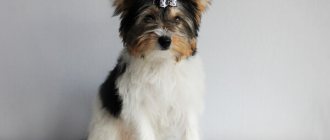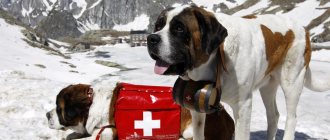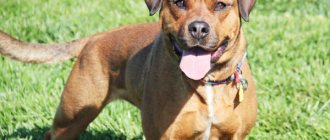Differences and similarities between the toy terrier and the Prague rat
Externally, these breeds are quite similar. But experienced dog breeders can easily distinguish them. But lovers and owners of pets of other species often confuse them.
The height of a ratlik (ratlik) is 18-23 cm, and a toy terrier is 28 cm. The first has large bones and weighs 2.6 kg. Toy – up to 3 kg.
The toy's ears are erect and set high, while the rat's ears are wide and at a slight angle to each other. The ratlik's muzzle is longer.
The top of the toy terrier gradually descends from the withers to the very tail; the rat dog has a straight back.
Characteristics of the Toy Terrier
Modern representatives of the Toy Terrier breed are small, long-legged dogs, curious, active, with an intelligent look. The animal is easy to train, but is not suitable for replacing service or hunting dogs.
The dog can be kept in an apartment and travel together.
The Toy Terrier's height is 20-28 cm, and its weight is 2-3 kg. The colors are black, blue, brown and tan, red, and has no spots, since this breed does not have a marble color.
The long-haired toy is distinguished by a small hairy coat (length - 3-5 cm), which requires daily care - combing.
Historical reference
Russian toys, as the name suggests, are toy-sized, but have a unique character. They feel responsible for the owner, and in a moment of danger they will rush to protect, and they also have high self-esteem.
The well-known terrier trembling is just a sign that the dog is seriously interested in something. History proves that the Russian Toy is a descendant of the English Toy Terrier, which was popular at the end of the 19th century. The duties of terriers included chasing rodents and catching rats.
Everyone was interested in small pocket dogs; not only noble ladies and kings, but also ordinary people, especially peasants, sought to purchase them.
But times have changed, and a wonderful Russian breed of decorative dogs has appeared. This happened in the 50s of the twentieth century in the USSR, the breed quickly fell in love with the entire Soviet Union and spread throughout the countries.
In 2006, two varieties of the breed were established based on coat length - smooth-haired and long-haired (up to 5 cm) terriers. The original Russian versions of the Toy Terrier breed are also famous for their size; they are divided into:
- Mini toy terrier (weight up to 1.8 kg and height up to 20 cm);
- An ordinary Russian Toy (with a weight from 1.8 kg to 3 kg, and a height of up to 26 cm).
Character and appearance
The Russian Toy Terrier is a brave, cheerful and loyal dog. The animal is immensely affectionate, sociable, quickly becomes attached to the owner, and can be very upset by his loss. Despite this trait, the dog tends to be suspicious of strangers and warn of danger. This pet has good endurance, which allows it to move and travel together with the toy terrier.
A little history
These miniature dogs are descended from black and tan Manchester Terriers, which were used to hunt rodents. Over time, the breed was divided into species that differed in size. The smaller dogs were called English Toy Terriers.
In the 19th century, Russian aristocrats became seriously interested in them and began to import them to their homeland. After the 1917 revolution, the population of miniature dogs declined sharply. It was possible to save part of the existing livestock only thanks to the efforts of a few enthusiasts. Due to the isolation of the USSR, it was impossible to replenish the gene pool with English dogs. Therefore, after some time, they acquired distinctive features and turned into a separate breed - the Russian Toy Terrier. Tiny dogs quickly gained popularity not only in their homeland, but also far beyond its borders.
Education and training
There are minimal requirements for such toy terriers, as they do not cause concern. And even if the puppy barks at passersby, such an offense may seem cute to them. But this is not the norm. Show dogs need to be taught to be touched by strangers and to react dispassionately to them. It is important for their psyche to have a calm attitude towards passers-by, neighbors, cars - the entire world around them. This is the basic point of socialization for almost any dog.
Don't know what to name your baby? Read the article: Choosing a nickname for a toy terrier boy and girl
The primary task is to instill in them the skills of maintaining personal hygiene and meeting their natural needs in the places designated by the owners. The same should be true with rest - the dog needs its own corner to sleep. It is important to immediately accustom the toy terrier to order in everything, to suppress the desire to spoil things and bite while playing. Read about what to do if your dog pees on the bed here.
See also: teaching a puppy to use the litter box (video)
The pet must respond, understand and fulfill basic requests. Training for almost all dogs is identical. The owners give commands to the toy terrier in a calm but confident voice, rewarding them for their execution. If you encounter difficulties in finding a common language with your pet, you should seek advice from a dog handler who knows the secrets of mutual understanding with animals.
Education and training
Some owners mistakenly believe that small dogs do not need training. As a result, they grow up with ill-mannered animals that climb on sofas, growl at random passers-by, jump on strangers and bark continuously over trifles. To prevent this from happening to your dog, you need to deal with it from the first days of its appearance in the house.
Of course, the long-haired toy terrier, a photo of which can be seen in today’s publication, does not have to undergo a full training course. For comfortable living together, it is enough for him to unquestioningly carry out several basic commands, including “Come to me”, “Place”, “Ugh”, Sit” and “Lie down”. If desired, the tiny dog can be taught several circus tricks. For the training process to be enjoyable for both you and the dog, it must be done in a playful way.
Breeding
This breed has few litters. Large fetuses complicate childbirth and make it painful. With a weight of 1.5 kg, the female is at risk for her life, and with less than 2 kg it is better to wait a little.
It is also worth familiarizing yourself with which puppies were born from the male that was used for mating. Often a small boy is selected so that the offspring of the toy terrier will also be miniature, and delivery will be easier. It is also impossible to breed a dog too early, since its body is growing until it is 15 months old.
Breeding is a big responsibility. The girl may have toxicosis, she may completely refuse to eat and then she will need the help of a veterinarian who will give appropriate recommendations.
Care and maintenance
Taking care of the Moscow Toy Terrier is not difficult at all.
- Ears are checked monthly and cleaned with a cotton pad.
- They monitor the loss of baby fangs, which can cause the formation of malocclusion in the toy terrier. Brush your dog's teeth regularly.
- Toys are bathed once every six months. More frequent water procedures are undesirable due to his dry and sensitive skin.
- Brush the dog daily.
- Puppies have their nails trimmed every 15 days, and adults – once a month. During seasons of walking on hard surfaces, the toy terrier’s claws wear down on their own.
- The young animal is walked 4 times a day. With an adult dog they go outside in the morning and evening.
Dog Feeding and Health
Breeders, according to the TOP 10 products for dogs, recommend purchasing premium dry food for your toy. They contain the necessary amount of nutrients that are needed for the proper development of animals.
At 2 months, the dog should eat 4 times a day. At the age of 6 months, 2 feedings are sufficient. However, you need to remember that the toy terrier cannot be overfed. Your pet's menu should include meat products every day. This can be beef, lamb, offal and chicken. Before serving, the meat must be doused with boiled water.
Treat your dog to fish and egg yolk several times a month. The menu should include cereals such as buckwheat and rice. Vegetables that your dog will benefit from include zucchini, cucumbers, bell peppers, tomatoes, carrots and cabbage.
Several times a week you need to give your dog fermented milk products: fermented baked milk, cottage cheese or kefir. And the pet’s favorite treat is apricots, apples, peaches, bananas and pears.
Remember that for a healthy dog you need not only good nutrition, but also the constant attention of your beloved owner.
It is important to remember that the most common ailments of representatives of this breed are:
- ear infections;
- dislocation of the kneecap;
- cataract.
Allergies in dogs are rare. Experts do not recommend purchasing a toy for small children, who, without calculating their strength, can injure a fragile pet during play.
At 2 months it is necessary to get the first vaccination. After vaccination, the dog cannot be bathed for 14 days. The next vaccine is administered to the animal at 7 months. Then vaccinations need to be repeated once a year.
Sources:
https://4lapki.com/2017/03/chto-izvestno-o-dlinnosherstnom-toy-terere
https://petguru.ru/porody/dlinnosherstnyj-toj-terer
https://lovegav.ru/toj-terer/dlinnosherstnyj.html#i-4
Feeding
It is better to decide in advance whether your pet will have a diet of natural products or specialized food. Veterinarians do not approve of mixed feeding for this breed. Do not be afraid of monotony when using ready-made food - these dogs tolerate it well.
The amount of food consumed by a toy terrier directly depends on the dog’s age and size. The information on the packaging will help you determine the norm.
When choosing food ingredients, take into account that neither the puppy nor the adult dog is fed the same dishes that the family eats. The animal needs an individual, balanced menu. Calculation of portions will be about 80 g per 1 kg of dog weight. Forbidden for a toy terrier are pasta, egg whites, sausages, smoked foods, sweets and sugar, fatty dairy products, everything hot and spicy.
A one and a half month old puppy has 6 meals a day, and they switch to 5 meals a day from 2 months; from 5 months the dog is gradually transferred to 4 meals a day. From 7, an animal needs three doses, and from 9 – 2 times a day.
Expert opinion
Anna Abramenko
An avid dog lover. Experience in veterinary medicine since 2009.
Ask a Question
Fish, lean meat, kefir, and vegetables are very useful for the toy terrier.
Health and treatment
Unfortunately, there are common diseases for this breed, many of which develop at the genetic level. The musculoskeletal system of miniature terriers is at risk for these reasons and due to increased activity. The dog needs attention to prevent injury.
Eye diseases, which include conjunctivitis and senile cataracts, also have a genetic predisposition.
Dogs of this breed often lose teeth early due to periodontal disease and tartar. Therefore, you need to monitor your toy terrier’s diet, brush it promptly, and remove plaque from the teeth.
Expert opinion
Anna Abramenko
An avid dog lover. Experience in veterinary medicine since 2009.
Ask a Question
It is worth asking about the presence of allergic reactions in the pet's parents; it is also often inherited.
Many neuralgic diseases appear in puppies and require surgical intervention.
Due to its fragile build, the dog does not tolerate weather changes well - heat, cold, rain. Therefore, your pet should be protected from hypothermia and overheating.
Symptoms of diseases in dogs of this breed:
- lethargy;
- refusal of food;
- temperature;
- the appearance of discharge from the eyes or nose.
Expert opinion
Anna Abramenko
An avid dog lover. Experience in veterinary medicine since 2009.
Ask a Question
You should not self-medicate your toy terrier or give medications at random, but it is better to show the animal to a veterinarian in a timely manner.
Lifespan
Representatives of this breed live 10-15 years, but some individuals have delighted their owners for 25 years. It all depends on the state of health, care and nutrition. Vaccination of the dog is mandatory.
Mini Toy Terriers are less likely than other relatives to be in good health. Their lifespan is 3-5 years. This is explained by the fragile health of all dwarf animals.
Expert opinion
Anna Abramenko
An avid dog lover. Experience in veterinary medicine since 2009.
Ask a Question
Wearing of teeth is an indicator of old age in pets, but for toys the situation is somewhat different, since this is a feature of the breed.
Advantages and disadvantages
This dog is very sociable. The Toy Terrier easily puts up with the rhythm of life of its owner and adheres to it.
The dog's disadvantages include some health problems, including genetic predisposition. The disadvantages include the presence of an explosive temperament and willfulness.
Expert opinion
Anna Abramenko
An avid dog lover. Experience in veterinary medicine since 2009.
Ask a Question
The pet should be raised from puppyhood, disciplined, and mutual understanding achieved. A pampered animal will get used to permissiveness, begin to demand the desired goodies, sleep on the bed and fully demonstrate the negative sides of its character.
Rules for choosing a puppy
Parameters by which a purebred toy terrier is selected:
- The weight of a three-month-old individual is at least 1-1.5 kg.
- The bite is scissor-shaped, and there should be 6 teeth between the canines on each jaw.
- A show pet is purchased at the age of 4 months.
- White spots on a Toy Terrier's body are not disqualifying, but are undesirable. Marble - tribal marriage. Long-haired puppies are characterized by feathering on their paws and ears.
- If your pet is inactive or shy, this may indicate a disease. It is better to repeat the visit and observe a second time, since activity and curiosity are inherent in this breed from an early age.
- Rash, bald spots, discharge, hot ears are bad signs for a toy terrier. There is no dandruff or redness in healthy pets.
- Particular attention should be paid to the gait and limbs of the terrier. Lameness is unacceptable.
- A puppy's timidity or angry mood is not a reason to refuse. Representatives of this breed love their owners, are cautious with strangers, and the potential buyer is not yet the owner. It is better to try to establish contact with the puppy and offer a treat.
How to care?
A lot depends on the care and training of this breed. It should be taught the rules of behavior in childhood, since it will be impossible to retrain an adult dog. Otherwise, these tailed friends of humans are not too demanding of their owner, and the main points for their care consist of the following points:
- As soon as you get yourself a puppy of this breed, immediately let him know who is boss in the house. He should not snap at you and follow all your commands,
- From a very early age, introduce him to other dogs and people often. This way he will grow up to be more tolerant of strangers and will not bark at them without reason,
- Since long-haired Toychiks have hair on their ears that allows dirt to accumulate in them, they need to be washed several times a week. Tar soap is best suited for this,
- their eyes almost never water, and if this does happen, it is most likely due to an allergic reaction. In this case, take your pet to the veterinarian as soon as possible.
- The claws of toys have a strong structure, so they are difficult to grind down. They should be trimmed at least once every few weeks. Overgrown claws will interfere with the dog’s free movement, contribute to deformation of the fingers and scratch your rugs,
- You should approach feeding carefully and not overfeed your pet. They often have problems with obesity, so do not give him anything beyond the norm, no matter how pleadingly he looks at you. Well, in general, this breed is most suitable for low-fat food and a mixed diet. You can also get by with premium dry food.
Puppy cost
The price of toy terrier puppies depends on the pedigree. Bitches are usually more expensive. Long-haired ones are also slightly more expensive than smooth-haired pets. In general, prices range from $200 to $700.
You should choose a puppy of this breed from nurseries or breeders. It would be a great idea to visit exhibitions and dog breeding clubs. It is necessary to choose a toy terrier with a stud book and get to know its relatives. This is required to be confident in the pet’s genetic predispositions.
Expert opinion
Anna Abramenko
An avid dog lover. Experience in veterinary medicine since 2009.
Ask a Question
There is no point in looking for high-breed puppies on message boards. Professional nurseries have personal resources. If the publication is posted by breeders, then it should contain detailed information about breeds and nicknames.
A responsible owner does not sell unvaccinated toy terrier puppies until quarantine (2.5 months).
How to choose a longhaired toy terrier puppy
It is best to purchase a puppy from specialized nurseries or from reputable breeders. This is the only way you can be sure that you are purchasing a purebred and healthy animal. Usually, famous nurseries have their own websites where breeders post photos and videos of newborn puppies so that potential buyers can book their favorite baby in advance. Puppies up to one and a half months old are offered for sale. By this time they already have baby teeth and have received their first vaccinations. When choosing a pet, pay attention to the puppy's eyes and ears, which should be clean.
A healthy baby's belly is usually soft and not bloated; the paws should be even. A soft, shiny coat also speaks about the pet’s health. All toy terrier puppies are curious and playful, so they immediately run to meet the new guest. The price of dogs depends on:
- exterior features;
- character and upbringing of the puppy;
- presence of titled parents;
- size.
Puppies of unusual color are much more expensive, and the presence of disqualifying signs, on the contrary, significantly reduces the price. In addition, the nursery may change the price depending on whether the animal is planned to be mated or participate in exhibitions. Prices in Moscow nurseries for long-haired toy puppies range from 20,000 rubles. up to 60,000 rub.
Reviews
Olga: “The dog is a real little friend, always bringing positive emotions with his activity and enthusiasm. But a pet does not impose society; the toy terrier has the patience to wait until the owners are free for joint leisure.”
Nikolay: “It is important to start raising a toy terrier in a timely manner. If you miss the right moment, he can easily become the master of the situation and show waywardness. Retraining a dog is much more difficult. This also applies to barking for no reason.”
Nikita: “We are very pleased with the purchase of this particular breed. The dog gets along well with children and goes for walks with them. Caring for a baby is not difficult, you just need to give your toy terrier time, care and love.”
Photo and video review
Graceful toy terriers often take part in exhibitions. A miniature companion and reliable friend. An active and kind dog with a charming look.
Price range
On average, for a long-haired toy terrier puppy without documents they will demand 12-17 thousand rubles, a puppy with a pedigree costs more - 30-50 thousand.
The cost is also affected by gender and color.
In toys, gender is weakly expressed, but this does not deprive the bitch of the ability to reproduce offspring, therefore the price of girls is higher than boys. Among the colors, blue and tan and lilac and tan are distinguished; red is cheaper.
The problem is that it is difficult to find a pet in the advertisements that will meet every breed standard. If the future owner is interested in the potential of the pet (for example, to participate in exhibitions), then the best solution would be to contact the nursery directly.


